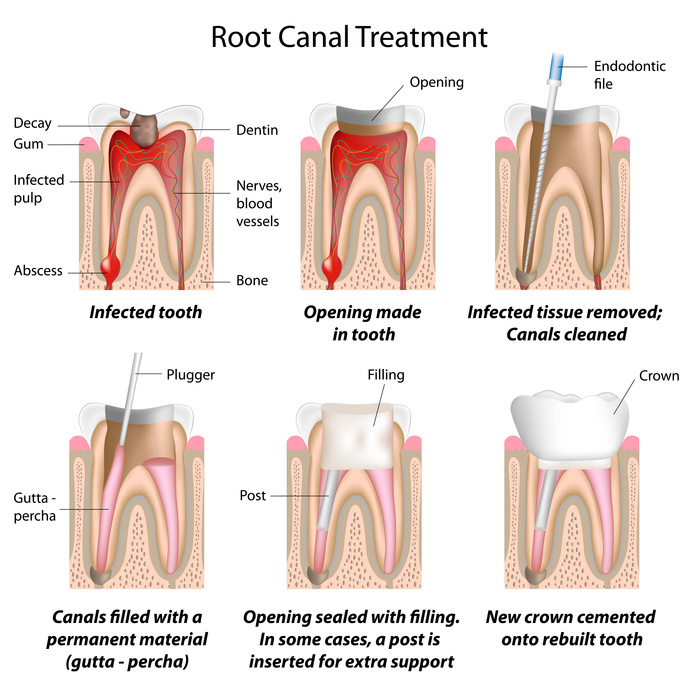Root canal treatment is a vital procedure designed to save a severely infected or decayed tooth. By removing the infected pulp and sealing the tooth, this treatment alleviates pain and prevents further complications, thus preserving oral health. However, many patients are concerned about the costs, which can vary widely. In Australia, the average cost of a root canal procedure ranges from $900 to $3,400 without a dental crown. Understanding these costs and the factors that influence them is crucial. This guide offers a comprehensive overview of what to expect financially and provides tips for managing expenses, helping you navigate this essential dental care with confidence.
In this blog:
- What is Root Canal Treatment?
- The Root Canal Procedure
- Factors Affecting the Cost of Root Canal Treatment
- Average Cost of Root Canal Treatment in Australia
- Breakdown of Costs
- The Importance of Quality
- Cost Comparison: Root Canal vs. Extraction and Other Alternatives
- Insurance Coverage and Payment Options
- Tips for Reducing the Cost of Root Canal Treatment
- Post-Treatment Costs and Maintenance
What is Root Canal Treatment?
Root canal treatment is a dental procedure used to treat infection at the centre of a tooth. This treatment is essential when the pulp, which contains nerves and blood vessels, becomes infected or inflamed due to deep decay, repeated dental procedures, or trauma to the tooth. The process involves removing the infected pulp, cleaning and disinfecting the inner chambers of the tooth, and then sealing it to prevent further infection. By saving the natural tooth, a root canal can prevent the need for extraction and maintain the tooth’s function and appearance.
Understanding the necessity and intricacies of a root canal can help patients appreciate its value, both in terms of oral health and cost efficiency. If you’re facing the possibility of needing a root canal, it’s crucial to understand not just the procedure itself, but also the various factors that influence its cost, which we’ll delve into in the following sections.

The Root Canal Procedure
A root canal procedure typically involves several steps, which are performed over one or more visits to the dentist:
- Assessment and Diagnosis: The dentist conducts a thorough examination, often including X-rays, to assess the extent of the infection or damage and to plan the treatment.
- Anesthesia: Local anesthesia is administered to numb the tooth and surrounding area, ensuring the patient is comfortable throughout the procedure.
- Accessing the Pulp: A small opening is made in the crown of the tooth to access the infected or inflamed pulp.
- Removing the Infected Pulp: The dentist uses special instruments to remove the infected pulp from the pulp chamber and root canals.
- Cleaning and Disinfecting: The empty canals are meticulously cleaned and disinfected to remove any remaining bacteria and prevent further infection.
- Shaping and Filling: The canals are then shaped and filled with a biocompatible material, usually gutta-percha, which is sealed with adhesive cement to ensure a complete seal.
- Restoration: Depending on the extent of the tooth structure removed, a temporary or permanent filling is placed. In many cases, a crown is recommended to restore the tooth’s full function and appearance.
- Follow-Up: The dentist schedules follow-up visits to monitor the healing process and ensure the success of the treatment.
The complexity and thoroughness of a root canal treatment highlight why costs can vary, as multiple factors influence the overall price, which we will explore in the next section. Understanding these elements can help you better anticipate the financial aspects of this vital dental procedure.
Suggested Reading: What Is A Root Canal? And Do I Need One?
Factors Affecting the Cost of Root Canal Treatment
Several factors influence the cost of root canal treatment in Australia, and understanding these can help you anticipate and manage your expenses:
Complexity of the Case
The severity of the infection and the complexity of the root canal system can significantly impact the cost. Molars, which have more roots and intricate canals, are generally more expensive to treat than front teeth.
Location of the Tooth
Root canals on front teeth (incisors and canines) typically cost less than those on premolars and molars due to the simpler anatomy and easier access.
Geographic Location
Dental costs can vary widely depending on the location of the dental practice. Major cities and affluent areas tend to have higher prices compared to rural or less populated regions.
Dentist’s Experience and Specialisation
Endodontists, who are specialists in root canal treatments, may charge more than general dentists due to their advanced training and expertise.
Additional Treatments Required
The need for additional procedures, such as dental crowns or fillings, can add to the overall cost. Crowns are often recommended after root canal treatment to restore the tooth’s strength and function.
Technology and Materials Used
Advanced technology and high-quality materials can improve the outcome of the procedure but may also increase the cost. This includes digital imaging, modern anesthesia techniques, and biocompatible filling materials.
Understanding these factors helps you grasp why prices can vary and what aspects to consider when discussing treatment options with your dentist. Next, we’ll look at the average cost of root canal treatment in Australia.
Need comprehensive dental care? Explore all our services at our Browns Plains Dental Clinic and ensure optimal oral health.
Average Cost of Root Canal Treatment in Australia

The cost of root canal treatment in Australia can vary widely depending on several factors. Here is a general breakdown of what you might expect:
- Front Teeth (Incisors and Canines): The average cost ranges from $900 to $1,500.
- Premolars: The cost typically ranges from $1,100 to $2,000.
- Molars: Due to their complexity, the cost can range from $1,500 to $3,400.
These costs generally include the consultation, the procedure itself, and necessary follow-up visits. However, additional costs may apply if a crown or other restorative work is required. Knowing the average costs can help you prepare financially and discuss payment options with your dental provider.
Breakdown of Costs
Understanding the breakdown of costs can help you prepare financially:
- Consultation Fee: An initial consultation is required to assess the tooth and plan the treatment. This fee is usually included in the total cost but can range separately from $50 to $200.
- Procedure Cost: This covers the actual root canal treatment, including anesthesia and the use of specialised equipment. This constitutes the bulk of the cost.
- Follow-Up Visits: Post-procedure check-ups are essential to ensure proper healing and success of the treatment. These visits are often included in the overall cost but can sometimes incur additional charges.
- Additional Treatments: If a crown or other restorative work is needed after the root canal, this will add to the overall cost. Crowns can range from $1000 to $2,500 depending on the material used.
By understanding these costs, you can better anticipate the financial requirements and plan accordingly for your root canal treatment.
The Importance of Quality
While it might be tempting to choose the least expensive option, it’s crucial to consider the quality of care. A higher cost often reflects better technology, more experienced practitioners, and higher-quality materials, which can lead to better outcomes and fewer complications.
Knowing these average costs and factors can help you prepare financially and discuss payment options with your dental provider. Always consult with your dentist to get an accurate estimate based on your specific situation and needs.
For more detailed information and personalised estimates, consider scheduling a consultation with a reputable dental clinic. This can provide a clearer picture of what to expect and help you plan accordingly.
Potential Costs of Not Getting a Root Canal Done
Neglecting to get a necessary root canal can lead to several serious and costly dental issues:
- Tooth Loss: The most immediate consequence of not treating an infected tooth is tooth loss, which can lead to further dental complications and affect your ability to eat and speak properly.
- Spread of Infection: An untreated tooth infection can spread to the surrounding teeth, gums, and even the jawbone, potentially leading to more extensive dental procedures and higher costs.
- Systemic Health Issues: In severe cases, a dental infection can enter the bloodstream and cause serious health problems, including heart disease and infections in other parts of the body.
- Increased Treatment Costs: Avoiding a root canal often leads to the need for more expensive treatments later on, such as dental implants, bridges, or dentures to replace lost teeth.
- Pain and Discomfort: Prolonged infection can result in significant pain and discomfort, affecting your quality of life and requiring emergency dental care, which can be more costly.
Considering these potential consequences highlights the importance of addressing dental issues promptly. Investing in a root canal treatment not only preserves your natural tooth but also prevents more severe health and financial complications in the future.
Maintain your oral health and prevent future issues. Explore our General Dentistry services for comprehensive care.
Cost Comparison: Root Canal vs. Extraction and Other Alternatives
When facing a significant dental issue, it’s essential to consider all treatment options and their associated costs. Here’s a comparison between root canal treatment and other common alternatives:
- Root Canal Treatment: While initially more expensive than a simple extraction, root canals preserve your natural tooth, maintain proper bite alignment, and prevent the need for more complex restorative procedures in the future.
- Tooth Extraction: This option is generally less expensive upfront. However, it often leads to additional costs associated with tooth replacement options such as dental implants, bridges, or dentures, which can be more expensive and less convenient in the long term.
- Dental Implants: Implants are a durable and effective replacement for extracted teeth, but they are significantly more expensive than root canal treatment, often costing several thousand dollars per implant.
- Bridges and Dentures: These are alternative options for replacing missing teeth but come with their own costs and maintenance requirements.
Choosing a root canal instead of extraction can be cost-effective in the long run by preserving your natural tooth and avoiding the need for further dental work. However, the best choice depends on individual circumstances, which should be discussed with your dentist.
Suggested reading: Root Canal Vs Extraction: How & When To Choose
Insurance Coverage and Payment Options
Understanding how to manage the cost of root canal treatment involves exploring insurance coverage and payment options:
Insurance Coverage
Many dental insurance plans cover part of the cost of root canal treatment, but coverage can vary. It’s important to check with your insurance provider to understand what portion of the treatment is covered and what your out-of-pocket expenses will be. Typically, insurance covers a percentage of the procedure cost, leaving the patient responsible for the remainder.
Payment Plans and Financing
Many dental practices offer payment plans to help manage the cost of treatment. These plans allow you to spread the cost over several months, making it more affordable. Additionally, some clinics may offer financing options through third-party providers, which can provide low or no-interest payment plans.
By understanding your insurance coverage and exploring payment options, you can better manage the financial aspect of your root canal treatment. This proactive approach helps ensure you receive the necessary care without undue financial stress.
Tips for Reducing the Cost of Root Canal Treatment
Reducing the overall cost of root canal treatment can be achieved through several strategies:
- Preventive Care: Regular dental check-ups and cleanings can help detect issues early, potentially avoiding the need for more complex and expensive treatments like root canals. Good oral hygiene practices at home are also crucial in preventing tooth decay and infection.
- Choose the Right Dental Clinic: Prices can vary between dental practices. Researching and comparing costs from different clinics can help you find more affordable options. However, it’s essential to balance cost with the quality of care.
- Inquire About Discounts: Ask your dental clinic if they offer any discounts for upfront payments or if they have special rates for certain times of the year. Some clinics provide discounts for senior citizens, students, or military personnel.
- Negotiate Payment Plans: Don’t hesitate to negotiate payment plans with your dental provider. Many clinics are willing to work with patients to create a payment schedule that fits their budget.
Implementing these strategies can help you manage and reduce the cost of root canal treatment, making it more accessible without compromising on the quality of care.
Post-Treatment Costs and Maintenance
After undergoing a root canal treatment, there are additional costs and maintenance considerations to keep in mind:
Aftercare Costs
Post-treatment care might include prescribed medications, such as antibiotics or pain relievers, to manage infection and discomfort. Additionally, follow-up visits to monitor healing progress can incur further costs.
Crowns and Restorations
In many cases, a crown is recommended to protect the treated tooth and restore its function. The cost of a crown can vary and should be factored into the overall expense of the root canal treatment.
Long-Term Maintenance
Maintaining the health of the treated tooth involves regular dental check-ups and cleanings. This ongoing care helps ensure the longevity of the root canal treatment and prevents future complications.
Potential Additional Treatments
If complications arise, such as persistent infection or structural issues with the tooth, further treatments may be necessary, adding to the overall cost.
Understanding and planning for these post-treatment costs and maintenance needs ensures that you are fully prepared for the financial and care aspects following your root canal treatment. This comprehensive approach helps maintain the health and function of your teeth in the long term.
Understanding the costs associated with root canal treatment in Australia is essential for making informed decisions about your dental care. By considering the factors that influence pricing, comparing costs with other treatment options, exploring insurance coverage and payment plans, and implementing strategies to reduce expenses, you can manage the financial aspect of this crucial procedure effectively.
Protect your tooth after a root canal with durable Crowns and Bridges. Discover your options now!
Root Canal Treatment at Dental Aspects

At Dental Aspects, we are committed to providing top-quality root canal treatments that prioritise patient comfort and successful outcomes. Our skilled dental professionals use advanced techniques and state-of-the-art technology to perform precise and efficient root canal procedures. From the initial consultation through to post-treatment care, our focus is on preserving your natural teeth and ensuring your overall oral health. We understand that the thought of a root canal can be daunting, so we offer a supportive environment and comprehensive care to alleviate any concerns.
Our services include detailed assessments to determine the necessity and scope of the procedure, expert execution to remove infection and restore tooth integrity, and thorough follow-up care to monitor healing and prevent further issues. At Dental Aspects, your dental health and comfort are our top priorities, ensuring that you receive the best care possible throughout your treatment journey.
Keep Reading: 8 Root Canal Myths Debunked


